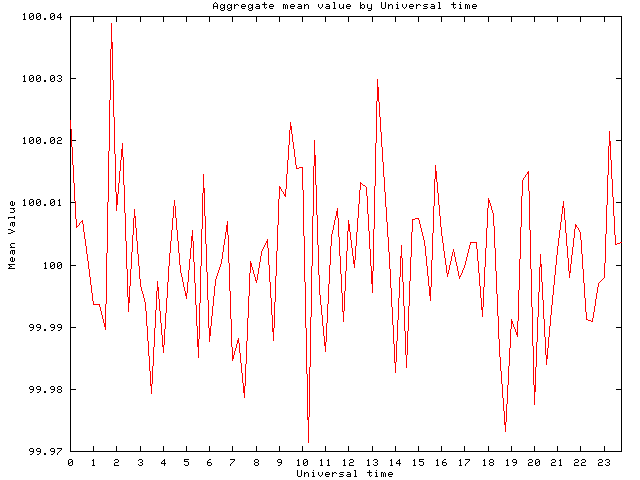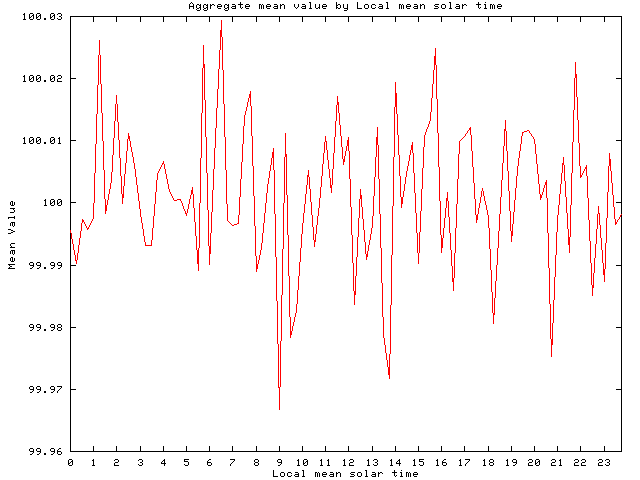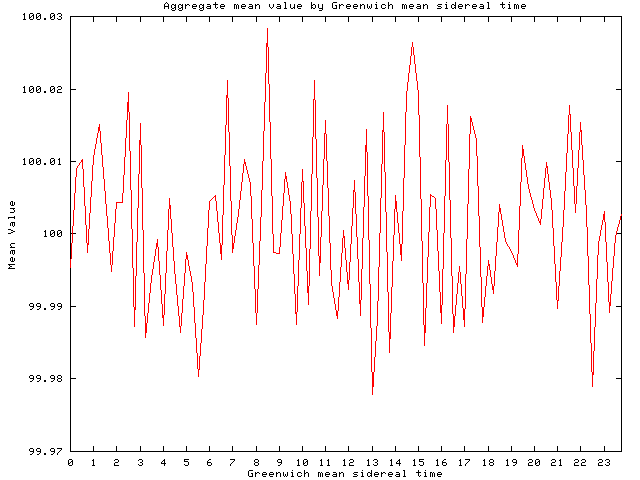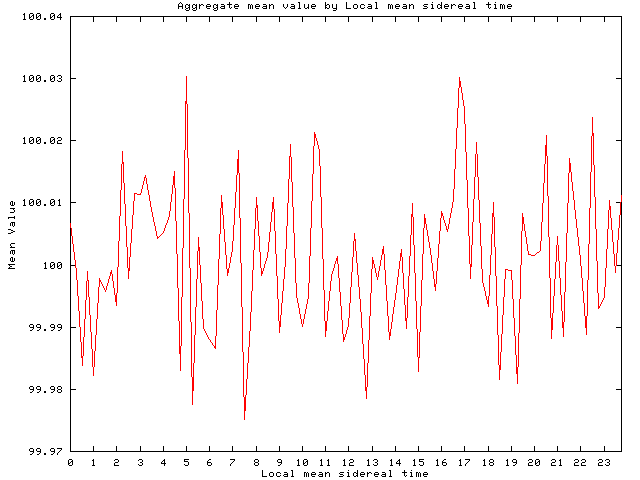
Download CSV data for this plot.
This report plots data collected to date from all egg sites, assembling data by time in a variety of different ways. These plots are intended to reveal any consistent time-dependence in the egg data and, if such is found, the nature of the correlation with time. This report is exploratory and qualitative in nature and does not perform any formal statistical or spectral tests on the collected data; it is intended merely to reveal potential periodicities which might merit further exploration, both in the historical database and as new data are collected.
The plots below are prepared in the following manner.
Scan historical database. The collected CSV-format
egg data summaries (which are available in the http://noosphere.princeton.edu/data/eggsummary/
directory as basketdata-YYYY-MM-DD.csv.gz
files) are read. Each record in these files represents the results for each egg reporting
in that day for an individual second of the day which the file represents.
Transform date and time. Time in the historical database is given in Universal (Greenwich Mean) time, and thus a record represents (to the precision of time alignment across the network) a simultaneous one-second interval in which all eggs took the samples present in the record. If we wish to explore dependence on other measures of time (for example, mean local solar time, which correlates with the day-night cycle at the egg site location), the Universal time in the record must be transformed, for each egg's data in the record, to the desired time. For example, to analyse data by local time, Universal Time would be adjusted by the time zone offset (or, for true solar time, longitude difference) between the egg site and the prime meridian. An auxiliary database of egg site locations is used to perform this transformation. Transformation of time may place the sample in a different day, but since we're interested only in diurnal correlations here, only the time is relevant.
Bin by time. The transformed time for each egg's result in the record is "binned" by assigning it to a 15 minute interval during the day (the program which produces the reports can use any binning interval--the plots below use the default binning of 15 minutes). Per-bin counters of numbers of trials and number of one bits are updated for the data from each egg reporting in the record.
Store and plot aggregate results. After all data in the database have been examined, the aggregate data for each bin is written to a CSV file in the following format:
| Field | Contents |
|---|---|
| 1 | Bin start time in seconds |
| 2 | One bits in trials in this bin |
| 3 | Trials in this bin |
| 4 | Mean for this bin |
The "Mean for this bin" field is simply the number of one bits divided by the number of trials, then multiplied by the standard 200 bits per trial; it is provided for convenience only and may be recomputed from the contents of fields 2 and 3. The time in field 1 is the transformed time selected for the individual report. Links below the charts allow you to download the data from which they were prepared.
This CSV summary file is then read by a small program which generates input for gnuplot to create the charts in PPM format, which is then translated to gif with utilities from the PBMplus toolkit.
| Database starts: | 1998-08-05 |
|---|---|
| Report ends: | 1998-11-01 |
| Total trials: | 7,115,859,000 |
| Total ones: | 3,557,960,649 |
| Aggregate mean: | 100.008755 |
This plot shows aggregate mean data binned by Universal (Greenwich Mean) Time (which also happens to be the form in which it is stored in the database). Data for all eggs is collected into a bin based on the Universal Time at which the egg performed the trial.

Download CSV data for this plot.
This plot shows aggregate mean data binned by the local mean solar time at the individual egg sites. Data for this plot are created by transforming Universal Time into an approximation of local time by adding the difference between the time zone in which the egg site is located and Universal Time (ignoring summer time, if applicable). This plot approximates the diurnal cycle at the egg site's location. Variants of this plot might account for summer time when in effect, or compute precise solar time based on the egg site's longitude.

Download CSV data for this plot.
This plot bins data based on Greenwich Mean Sidereal Time, which is representative of the position of the Earth with respect to the distant stars. As the Earth orbits the Sun, we view the sky from a slightly different vantage point on successive days, with the result that a given star will cross (transit) the meridian above a location on the Earth's surface 23 hours, 56 minutes, 4.09 seconds after its last transit--about four minutes less than the time between transits of the Sun (or, in other words, "a day"). In the following chart, then, data from all eggs are binned by the position of the Earth, as a whole, with respect to objects beyond the Solar System.

Download CSV data for this plot.
The following plot bins data by an approximation of the local sidereal time at each individual egg site. This is computed by first calculating the sidereal time at Greenwich, as above, then adjusting the time for the difference in latitude between the egg site and the prime meridian. This is presently done based on time zone offsets and may be in error by up to 15° (one hour). This will be replaced by precise longitude data for the egg sites once it is available.
Binning by local sidereal time aggregates data based on the apparent position of celestial objects beyond the solar system at each individual egg site. For example, at about 17:42 local sidereal time the centre of the Milky Way galaxy will transit the meridian above an egg site.

Download CSV data for this plot.
These plots may suggest other time-dependent analyses which might be performed on the
data collected by the Global Consciousness Project. For example, one might want to bin by
the apparent position of the Moon by egg site to investigate tidal effects, or by the
phase of the Moon for potential correlates. To further explore time dependencies in the
collected data, you can download the Perl programs used to prepare this report. Simply
modify the TransformTime subroutine in longwave.pl to perform
whatever transformation you wish, and run the report over the collected
CSV databases on the Project server.
by John Walker
Last update: 1998-11-02